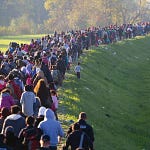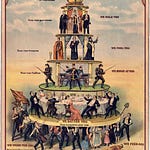Written by Matthew Archer.
The picture above shows one of the two 9/11 memorial pools. The names of the people who were killed in the 2001 terrorist attacks are inscribed on bronze parapets. Google tells us that 2,977 people were murdered in the attack. Then there are indirect deaths. Those who, for example, died from cancers caused by the toxic fumes many — most notably, firefighters — endured. The 9/11 Memorial Glade (see a picture below) was erected to remember these indirect deaths. Their website states:
On the day of the attacks and throughout the recovery, hundreds of thousands—responders and survivors, workers and residents—were exposed to hazards and toxins in the air at and around the World Trade Center site, resulting in chronic illnesses and the deaths of thousands.
But then there are the less obvious indirect deaths. The attacks cost the US about 55 billion dollars in damages, alone. If we added in the costs of the subsequent war on terror, economic impact and the increased cost of homeland security, the figure skyrockets to between 3-6 trillion dollars. Undoubtedly there are innumerable ways to convert this figure into deaths, but perhaps people would consider that method of accounting too crude and too removed from the 9/11 attack.
Instead, let’s focus on a simpler set of indirect deaths. For example, the people who chose to drive instead of fly in the immediate years after 9/11. It’s estimated that there were between 1,500 and 2,100 extra automobile deaths. That is a resounding win for the terrorists: creating enough fear so that people change the way they live. Shouldn’t these deaths be part of a memorial process? Granted we don’t know who precisely all these people were, but we know that they exist.
The road deaths raise another interesting question: why did they occur? After all, for approximately 2,000 excess deaths to occur many more people would have had to choose to drive instead of fly. Whether they were making conscious decisions to switch transport or not, most probably fell prey to what behavioural economists call the Availability Bias.
This bias occurs when we’re trying to work out how much care we should take in avoiding risks, like that of terrorism. As the Nobel Prize winning economist Richard Thaler writes in his book, Nudge:
If people can easily think of relevant examples, they are far more likely to be frightened and concerned than if they cannot. A risk that is familiar, like that associated with terrorism in the aftermath of 9/11, will be seen as more serious than a risk that is less familiar, like that associated with sunbathing or hotter summers. Homicides are more available than suicides, and so people tend to believe, wrongly, that more people die from homicide.
He goes onto note that:
If you have personally experienced a serious earthquake, you’re more likely to believe that an earthquake is likely than if you read about it in a weekly magazine. Thus, vivid and easily imagined causes of death (for example, tornadoes) often receive inflated estimates of probability, and less-vivid causes (for example, asthma attacks) receive low estimates, even if they occur with a far greater frequency (here, by a factor of twenty). Timing counts too: more recent events have a greater impact on our behavior, and on our fears, than earlier ones.
Professor Michael Rothschild applied this bias to governments, arguing that they overstated the risks after 9/11. Rothschild calculated the risk of a traveller who took four flights every month dying as a result of terror attacks. If hijackers managed to destroy one plane a month this frequent traveller had a 1 in 540,000 chance of being killed. At one plane a year, the risk was less than 1 in 6,000,000. In contrast, the risk of being killed in a US car accident in any given year is 1 in 7,000, dying of cancer is 1 in 600 and dying of heart disease 1 in 400.
At a governmental level we should realise that, in the words of Professor Gerd Gigerenzer, “decision-making is defensive”. Politicians would be held responsible if a plane crashed when flying through an ash cloud, even if it were deemed safe to do so. But politicians won’t be blamed if people are killed because they are forced to take their car instead of flying.
And at the individual level, just remember that the next time you’re thinking about risk or changing your behaviour, the number of immediate examples which come to mind probably have no bearing on the statistical reality. Swimming on the beach known for shark attacks is almost always many times safer than driving to the beach in a car.
Matthew Archer is Editor-in-Chief of Aporia.
Follow us on Twitter and consider supporting us with a paid subscription for just $6.99 a month:
















The unspoken deaths of 9/11